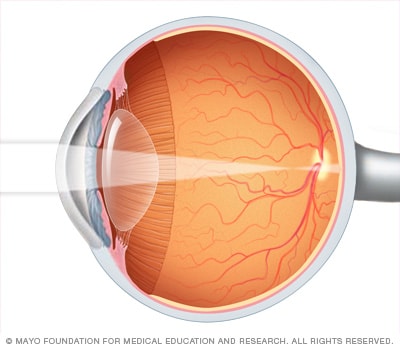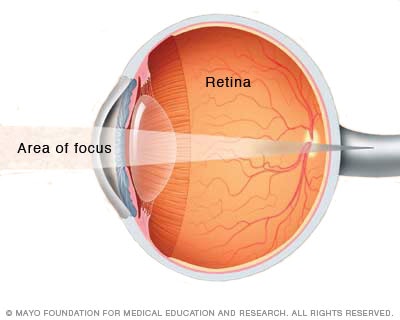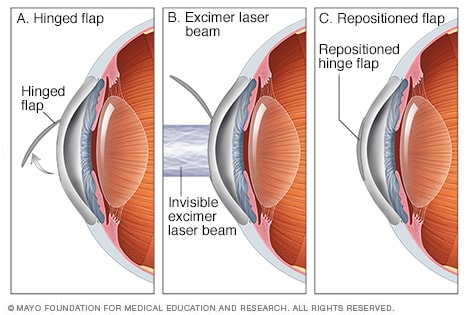Laser Surgery : Know The Risks
"My vision is considered 20/20, because I see the As, Bs and Cs all the way down the chart."
"But I see three As, three Bs, three Cs."
Geobanni Ramirez, Lasik patient
"Patients undergoing Lasik surgery should be adequately counseled about the possibility of developing new visual symptoms after surgery before undergoing this elective procedure."
Report on clinical trial, U.S. Food & Drug Administration
"We want the F.D.A. to warn the public that Lasik injures eyes and causes pain, vision problems and other persistent problems that cannot be solved -- and that you don't get these problems from glasses or contact lenses."
Morris Waxler, retired senior F.D.A. official
"No eye is optically perfect, and all eyes [with or without Lasik] have at least some degree of higher-order aberrations."
"These irregularities can cause visual distortions."
Dr. John Vukich, official, American Society for Cataract and Refractive Surgery
"There is nothing wrong with eyes that undergo Lasik except for the fact that they need glasses for distance."
"They [patients] see well before the procedure and ought to see equally well after the procedure. But they don't."
Dr. Cynthia MacKay, opthalmologist, Lasik critic

Anatomy of the eyeYour eye is a complex and compact structure measuring about 1 inch (2.5 centimeters) in diameter. It receives millions of pieces of information about the outside world, which are quickly processed by your brain.
Eye doctors performing the surgery assure the public that the procedure is guaranteed to give them total satisfaction. That assurance has resulted in a wide public acceptance and the perception that this surgery is indeed without concern, that the promise of improved eyesight and the abandonment of eyeglasses is a surety. Geobanni Ramirez, a 33-year-old graphic artist, has undergone his own epiphany and he begs to differ. Laser surgery has left him with light sensitivity, double vision and visual distortions that expose him to halos appearing around bright objects. Vehicle headlights are transformed into starbursts of blinding intensity.
He also experiences dry, sore eyes requiring drops every half-hour or so and the drops themselves burn. He has been left with poor eyesight such that even venturing out at night when darkness falls is concerning. Like the old dark humour that had a surgeon remarking that the operation he had conducted went very well; unfortunately the patient died, he has been told by his eye surgeon that his is yet another success story in Lasik surgery. An assurance that means nothing to him, but which complements the fact that prior to surgery he was never given a heads-up that permanent damage might occur following surgery.

Nearsightedness (myopia)With normal vision, an image is sharply focused onto the surface of the retina. In nearsightedness (myopia), the point of focus is in front of the retina, making distant objects appear blurry.
Of that number, close to one-third developed dry eyes, representing a complication capable of causing serious discomfort. Nonetheless there are many doctors whose professional careers revolve around Lasik surgery, and they dedicate themselves to convincing potential new patients that Lasik remains the safest procedure for eye correction, and that it is "exceedingly rare" that serious complications could arise from the surgery. Among these doctors there are some who may admit that post-surgery patients may require the use of eyeglasses at times.

Farsightedness (hyperopia)With normal vision, an image is sharply focused onto the retinal surface. But, if you're farsighted, your cornea doesn't refract light properly, so the point of focus falls behind the retina. This makes close-up objects appear blurry.
Studies exist that suggest there may be an increased risk for long-term eye complications, including possibly earlier cataract surgery required by Lasik patients. As well as the potential for developing corneal ectasia, a serious vision-threatening condition. Lasik (laster-assisted in situ keratomileusis), in a fifteen-minute procedure, eliminates the requirement to wear glasses through the reshaping of the cornea, the clear, round dome covering the eye. The cornea focuses light on the retina at the back of the eye.
Lasik surgeons make use of an ultraviolent laser to reduce the cornea curvature for near-sighted people, and to accent the curve for those who are farsighted. According to Dr. Cynthia MacKay, an ophthalmologist who decries the procedure, this surgery has the potential to injure the eye because it severs tiny corneal nerves, thins the cornea thus making it weaker, and permanently alters the eye's shape. Should all this knowledge of possible side-effects and injuries stemming from the procedure be widely disseminated as its critics would like, the elective procedure would become far less popular.

LASIK surgeryDuring LASIK eye surgery, an eye surgeon creates a flap in the cornea (A) — the transparent, dome-shaped surface of the eye that accounts for a large part of the eye's bending or refracting power. Then the surgeon uses a laser (B) to reshape the cornea, which corrects the refraction problems in the eye (C).
Labels: Bioscience, Complications, Eyesight, Laser Surgery, Technology

0 Comments:
Post a Comment
<< Home